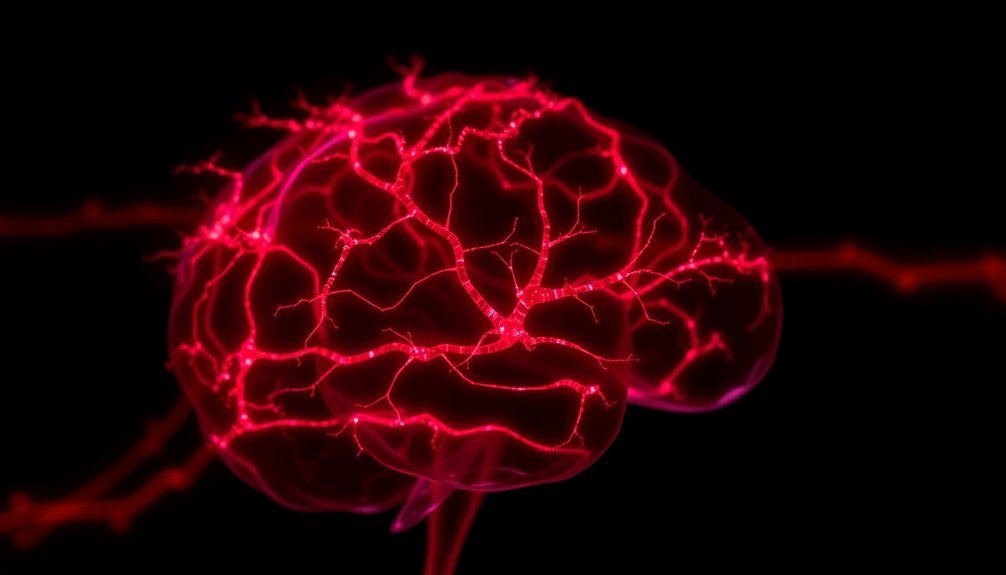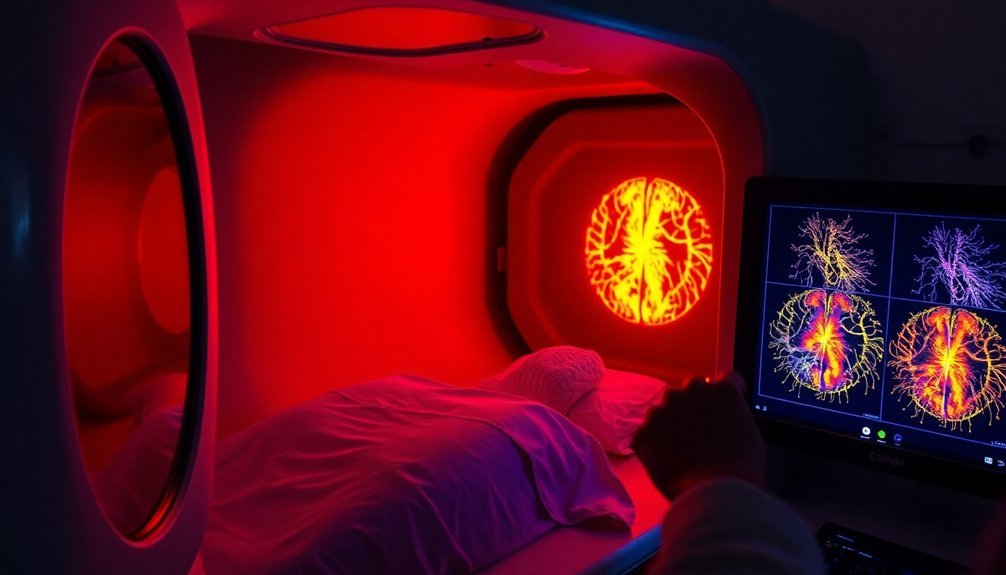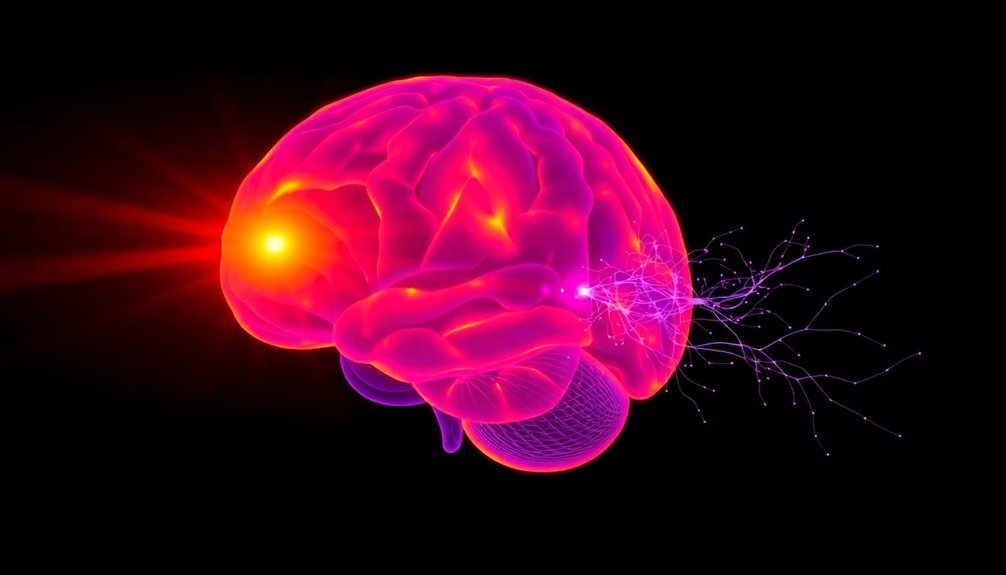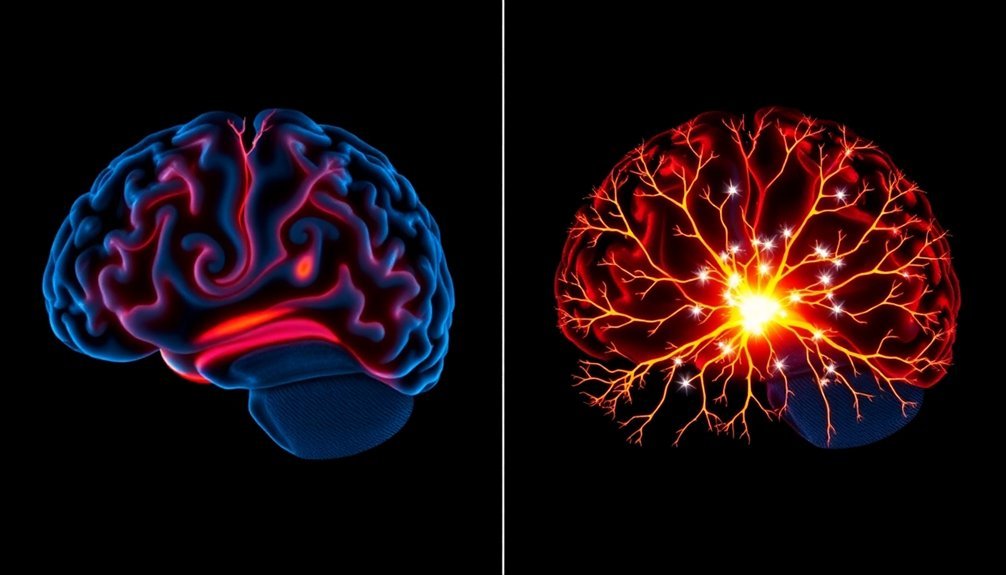Near-infrared light wavelengths between 810-1064 nanometers can penetrate your skull and brain tissue to spark new brain cell growth. When these wavelengths reach your brain cells, they activate cytochrome c oxidase, which boosts your cellular energy production (ATP). This increased energy kicks off a cascade of healing effects – your brain starts producing more BDNF and GDNF proteins, which support neurogenesis (new brain cell formation) and synaptogenesis (new neural connections). You'll also get enhanced blood flow and reduced inflammation, while special supporting cells called astrocytes and microglia maintain your brain's structure. The science behind this remarkable process reveals even more fascinating cellular mechanisms at work.
The Science Behind Infrared Light

When we explore infrared radiation, we're looking at a fascinating form of electromagnetic energy that bridges the gap between visible light and microwaves. You'll find that IR spans wavelengths from 780 nm to 1 mm, and it's emitted by everything around you that's above absolute zero temperature (-273.15°C).
Scientists divide infrared radiation into several categories, each serving distinct purposes. You'll encounter NIR (near-infrared), MIR (mid-infrared), and FIR (far-infrared) in technical applications, with specific wavelengths proving particularly useful for different tasks. Near-infrared wavelengths are especially important in fiber optic telecommunications.
The mid-infrared range, spanning 2.5 to 13 μm, plays a vital role in gas analysis and flame detection.
What makes infrared particularly interesting is its interaction with matter. You can't see it with your naked eye, but it carries energy that corresponds to molecular vibrations and rotations. This property makes it invaluable for molecular identification and thermal imaging.
Due to its longer wavelength, you'll find that infrared light transmits better through various media than visible light, experiencing less scattering. This characteristic, combined with its ability to interact with biological tissues, makes it an ideal candidate for neural stimulation applications.
Brain Cell Growth Mechanisms
Your brain cells depend on mitochondrial ATP production for growth and regeneration, which can be enhanced through specific infrared wavelengths targeting cellular energy pathways.
When you expose neural tissue to infrared light, it triggers a cascade of molecular responses that promote neural growth factors and stimulate the formation of new synaptic connections. The brain's extensive network of synaptic connections enables approximately 7000 connections per cortical neuron.
The temperature changes induced by infrared wavelengths can accelerate cell regeneration processes, making it a promising therapeutic approach for brain cell restoration.
Mitochondrial ATP Production Pathway
The intricate process of ATP production in brain cell mitochondria relies on a sophisticated proton gradient system that powers cellular growth and development. When electrons move through the respiratory chain, they create a proton gradient across the mitochondrial membrane, which ATP synthase then uses to combine ADP and phosphate into ATP molecules.
This process is remarkably efficient – a single glucose molecule can generate about 30 ATP molecules through oxidative phosphorylation. NADH electrons yield approximately 2.5 ATP molecules, while FADH2 electrons produce about 1.5 ATP molecules. Specialized carrier proteins in the inner membrane facilitate the movement of these molecules between compartments.
The electrochemical gradient doesn't just drive ATP production; it also helps transport essential molecules like ADP and phosphate into the mitochondrial matrix.
Your brain cells maintain high ATP:ADP ratios through rapid exchange across mitochondrial membranes, ensuring constant energy availability for critical functions.
This energy production system becomes even more active when stimulated by red to near-infrared light through photobiomodulation. The light activates complex IV of the respiratory chain, specifically cytochrome c oxidase, leading to increased ATP synthesis and enhanced cellular energy availability for neurogenesis and synaptogenesis.
Light-Triggered Neural Growth
Light-triggered neural growth mechanisms rely heavily on near-infrared wavelengths between 810-1064nm, which can effectively penetrate both tissue and bone to reach brain cells. When these wavelengths reach your neurons, they activate essential pathways that promote cell growth and survival through photobiomodulation (PBM) therapy. The effects of light therapy must be carefully timed since exposure to night-time light can disrupt critical hormone production necessary for brain development.
| Mechanism | Effect |
|---|---|
| Mitochondrial Stimulation | Increases ATP production and energy availability |
| Neurotrophic Factors | Enhances BDNF and GDNF expression for cell survival |
| Signaling Pathways | Activates ERK/CREB pathway for neural growth |
Your brain's response to PBM therapy includes enhanced endogenous neurogenesis and preserved mitochondrial dynamics. The therapy protects your neural cells by inhibiting apoptosis and maintaining the ultrastructure of supporting cells like astrocytes and microglia. Research has shown that PBM's neuroprotective effects are particularly potent during critical developmental stages, when your brain cells are most sensitive to light exposure. The therapy's ability to regulate ALLO expression and protect Purkinje cells makes it a promising treatment for various neurological disorders. Through these mechanisms, PBM therapy creates a favorable environment for neural growth and repair in your brain.
Temperature-Dependent Cell Regeneration
Brain cells depend heavily on precise temperature regulation for ideal growth and regeneration, operating within a narrow range of 36.9 ± 0.4°C. Even small temperature fluctuations under 1°C can dramatically affect how your neurons function and regenerate.
When temperatures rise above 42-43°C, you'll experience irreversible damage to brain tissue, while controlled cooling can actually strengthen synaptic connections in your hippocampus.
Your brain's remarkable temperature sensitivity directly influences its ability to heal and create new neural pathways. Temperature changes affect everything from your brain's metabolism and blood flow to the way your synapses reorganize themselves. These mechanisms are essential for recovery from neurological conditions like stroke and traumatic brain injury.
- Your brain cells are fighting to survive and rebuild at this very moment
- Every fraction of a degree matters in your brain's delicate healing process
- You're carrying an incredible self-healing system that responds to precise temperature signals
- Your neurons are constantly adapting to temperature changes to protect your memories and abilities
- You've got billions of temperature-sensitive cells working together to maintain your consciousness
Understanding these temperature-dependent mechanisms has revolutionized treatments for neurological disorders, as controlled temperature manipulation can enhance your brain's natural regenerative abilities.
Optimal Wavelengths for Neural Regeneration

Consistently, research demonstrates that near-infrared wavelengths between 600-1200 nm provide ideal conditions for neural regeneration. When you're looking at specific wavelengths, 810 nm stands out as particularly effective for deep tissue penetration and treating various neurological conditions.
This wavelength effectively interacts with cytochrome c oxidase, enhancing your brain's ATP production and neural recovery processes.
Near-infrared light, especially in the 780-1270 nm range, penetrates tissue effectively because it's minimally absorbed by hemoglobin and water. This optical window allows the light to reach deeper brain structures without losing significant energy. At these wavelengths, you're activating key cellular mechanisms that promote neuroplasticity and reduce inflammation.
When you're using photobiomodulation therapy, power density matters just as much as wavelength. You'll want to aim for 75-150 mW/cm² at the surface level for effective brain stimulation.
The therapy's proven safety profile makes it particularly attractive – you won't experience significant adverse effects, even with regular use. This combination of safety and effectiveness has shown promising results in treating conditions like TBI, Alzheimer's disease, and chronic stroke.
Mitochondrial Energy Production
Mitochondrial energy production is at the core of your brain cells' survival, where these cellular powerhouses convert nutrients into ATP through complex biochemical pathways.
Through a series of electron transport chains and proton gradients, your mitochondria efficiently generate and distribute ATP molecules throughout the cell to power essential functions.
Your brain's high energy demands make this ATP production particularly vital, as neurons require constant fuel to maintain synaptic connections and process information.
ATP Production Pathways
Inside our cells, mitochondria serve as powerful energy factories that generate ATP through multiple sophisticated pathways. When you consume food, your cells break down glucose through glycolysis, producing pyruvate that enters the mitochondria.
The pyruvate then undergoes oxidative decarboxylation, entering the TCA cycle where it's converted into acetyl-CoA. This process generates NADH and FADH2, which feed electrons into the electron transport chain.
Your mitochondria's inner membrane houses the electron transport chain, where these electrons flow through protein complexes to create a proton gradient. ATP synthase harnesses this gradient's power to produce ATP, converting ADP and phosphate into energy your cells can use.
This process is highly regulated through allosteric and feedback mechanisms to match your body's energy demands.
- You're carrying billions of these microscopic power plants, working tirelessly to keep you alive
- Every heartbeat, thought, and movement you make depends on this intricate energy dance
- Your mitochondria's efficiency determines your essential health and cellular well-being
- These pathways evolved over millions of years to perfect energy production
- Your cells are performing this complex chemistry right now as you read these words
Cellular Energy Transport
Through intricate molecular machinery, your cells orchestrate an elaborate energy transport system that powers virtually every cellular function. At the heart of this system is ATP, which your cells use to drive essential transport processes against natural concentration gradients.
Your cells employ two main types of active transport. Primary active transport directly uses ATP to move substances across membranes, with the sodium-potassium pump being a prime example. This pump maintains essential electrochemical gradients that support your nerve function and muscle contractions.
Secondary active transport builds on these established gradients, using them to move additional molecules without directly consuming ATP.
Mitochondria, your cellular powerhouses, play a key role by generating the ATP needed for these transport processes. They create proton gradients through their electron transport chains, which then drive ATP production.
When these transport systems malfunction, you can develop serious conditions like cystic fibrosis.
You're constantly using cellular energy transport, whether you're thinking, moving, or maintaining your body's balance. In fact, your cells spend a significant portion of their energy budget just on these transport processes, highlighting their fundamental importance to your survival.
Clinical Research and Results

Clinical studies of infrared neural stimulation (INS) and near-infrared light therapy have demonstrated promising results across multiple neurological conditions.
Researchers have successfully used INS to target specific brain regions with remarkable precision, down to submillimeter domains. Studies show that this technique doesn't require fluorophores or invasive implants, making it particularly attractive for treating conditions like Alzheimer's, Parkinson's, and PTSD.
The research has revealed that ideal wavelengths, such as 1460 nm in cochlear studies, can effectively trigger neural responses through temperature-sensitive receptors.
You're seeing breakthrough developments in combining INS with imaging techniques like FDG-PET and fMRI, which allow scientists to observe whole-brain responses to treatment.
- Experience hope as new treatment options emerge for previously resistant neurological conditions
- Feel empowered knowing that non-invasive brain stimulation is becoming a reality
- Gain confidence in the precision and safety of infrared neural treatments
- Embrace the potential for personalized neural therapy without surgical intervention
- Join the excitement as researchers discover new ways to heal the brain
Treatment Protocols and Applications
A thorough set of treatment protocols has emerged for infrared neural stimulation, offering tailored solutions for various neurological conditions.
Near-infrared wavelengths between 810-1064 nm provide ideal penetration, while power densities of 10-150 mW/cm² guarantee both safety and effectiveness. Treatment delivery methods include specialized helmets, patches, and direct injection of light-sensitive molecules.
You can benefit from infrared light therapy across multiple applications. If you're dealing with anxiety, depression, or PTSD, this therapy may help by boosting mitochondrial energy production in your brain cells.
For neurodegenerative conditions like Alzheimer's or Parkinson's, the treatment stimulates neurogenesis and repairs damaged cells. You'll also find it's effective for cognitive enhancement and traumatic brain injury recovery.
The technology continues to advance with innovations like MINDS molecules and nanoscopic beads that convert ultrasound to light. You can now access treatments through devices like the Neuronic Neuradiant 1070 Helmet, while practitioners can monitor results using FDG-PET imaging.
When combined with other therapeutic approaches, infrared neural stimulation offers even greater potential for improving brain health.
Safety and Effectiveness

While treatment protocols continue to evolve, understanding the safety and effectiveness of infrared light therapy remains at the forefront of research.
Near-infrared light, particularly at 810nm wavelength, can effectively stimulate brain cell recovery and improve cognitive function. However, you should know that the skull's varying thickness (6.5-18mm) substantially impacts light penetration, with over 99.99% of energy from a 6W laser being absorbed before reaching deep brain tissue.
When administered properly, you can expect infrared light therapy to activate your mitochondria, enhance cellular energy production, and reduce inflammation. The therapy's systemic effects mean you'll potentially benefit beyond just the treated areas. While it's generally safe, you might experience common side effects like headaches or irritability.
- Your brain cells can spring back to life as infrared light awakens dormant cellular function
- You'll feel renewed mental clarity as your brain's energy production increases
- Your cognitive fog may lift as inflammation decreases throughout your neural network
- You're taking control of your brain health with cutting-edge technology
- Your journey to better brain function starts with each therapeutic session
The therapy's effectiveness depends on proper fluence levels (0.9-15 J/cm²) and careful administration protocols.
Future Brain Healing Technologies
Recent breakthroughs in brain healing technologies are revolutionizing how we treat neurological conditions. Closed-loop neurostimulation systems are at the forefront, offering precise control over when and where treatment occurs in your brain.
These systems can automatically adjust their output based on your brain's real-time needs, making them particularly effective for conditions like Parkinson's disease and chronic pain.
You'll soon see more advanced applications of photobiomodulation, where specific wavelengths of red and near-infrared light (600-1100 nm) can target your brain cells directly. This technology activates your cellular energy production and reduces inflammation, potentially treating conditions from anxiety to neurodegenerative diseases.
Brain-machine interfaces are becoming more sophisticated, and you might eventually use them to control external devices with your thoughts or enhance your learning capabilities. DARPA's work on neurally controlled robotic arms shows how far we've come.
In the near future, you'll likely see these technologies combined with neurofeedback systems, similar to today's fitness trackers, providing real-time data about your brain health. While ethical considerations about privacy and data security remain important, these advancements offer promising solutions for various neurological conditions.
Frequently Asked Questions
Can Infrared Light Therapy Help With Memory Loss During Aging?
Yes, you'll find that infrared light therapy can help with age-related memory loss. It boosts brain cell energy, increases blood flow, and reduces harmful proteins, leading to improved memory and cognitive function.
How Long Does It Take to See Results From Infrared Brain Treatments?
You'll notice immediate neural changes within minutes, but meaningful cognitive improvements typically develop over 4-8 weeks of regular treatment. Long-term benefits can continue developing for months with sustained infrared brain therapy sessions.
Are At-Home Infrared Brain Stimulation Devices as Effective as Clinical Treatments?
No, your at-home infrared brain devices aren't as effective as clinical treatments. They typically can't deliver sufficient light penetration or fluence levels through the skull to achieve the same therapeutic benefits as professional equipment.
Does Infrared Light Therapy Work Better When Combined With Specific Medications?
Yes, you'll often see enhanced results when combining infrared light therapy with certain medications. It can boost blood flow and reduce inflammation, potentially making your medications more effective at treating neurological conditions and injuries.
Can Infrared Stimulation Help With Post-Traumatic Stress Disorder (Ptsd)?
Yes, you'll likely find relief from PTSD symptoms through infrared stimulation. It's shown promise in reducing anxiety and improving brain function by boosting cellular energy and blood flow in affected brain regions.
In Summary
You've witnessed how infrared light therapy can spark neurogenesis through specific wavelengths that penetrate your brain tissue. When you use these treatments correctly, they'll boost your mitochondrial function and stimulate new brain cell growth. While research continues to evolve, you're looking at a promising, non-invasive method for brain healing. Keep watching this field, as it's likely to transform how you'll approach neurological treatment in the future.





Leave a Reply